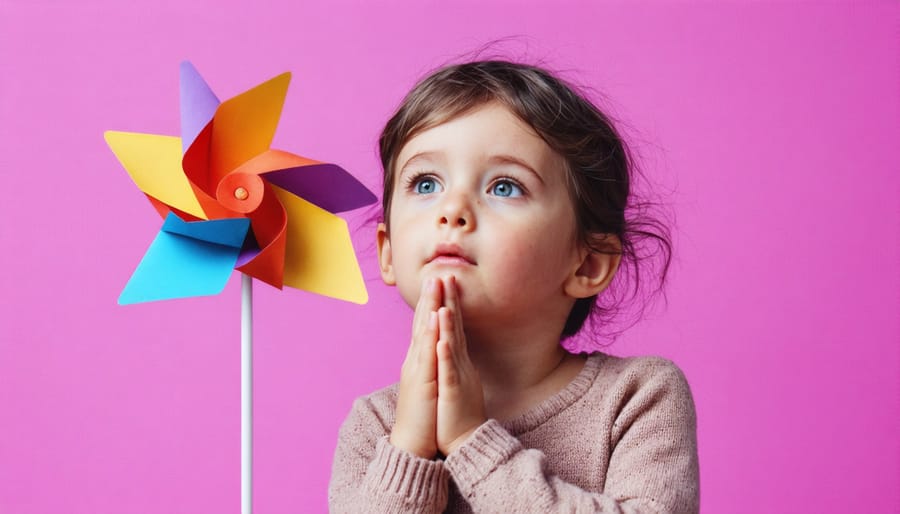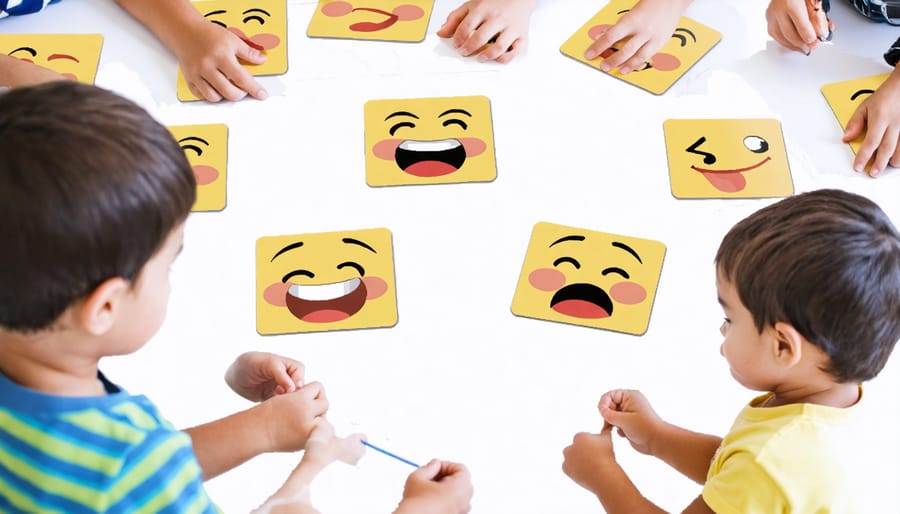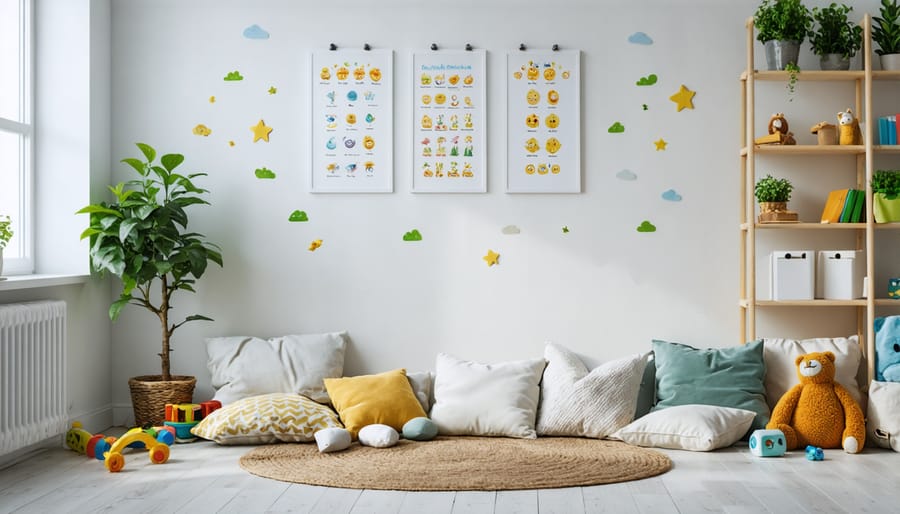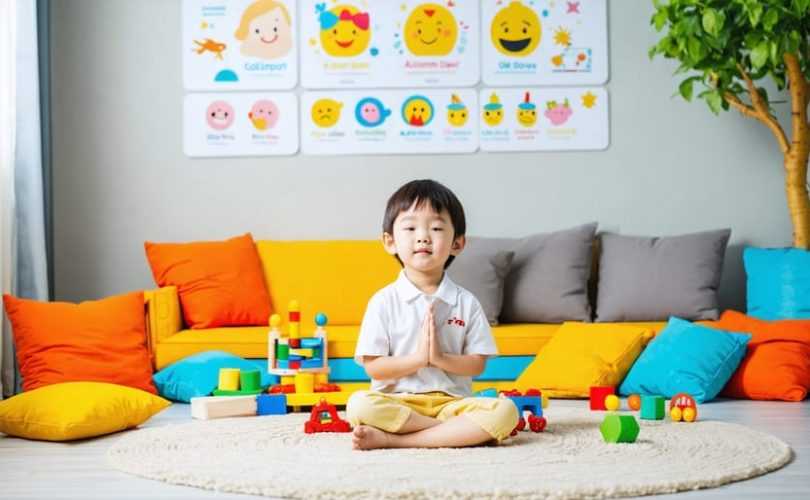Teaching children to regulate their emotions starts in the everyday moments we share with them. When your child feels overwhelmed, create a dedicated “calm down corner” with soft pillows, fidget toys, and breathing cards they can use independently. Guide your little one through simple mindfulness exercises, like pretending to blow up a balloon or counting colorful objects in the room, to shift their focus during intense emotional moments. Practice naming feelings together using picture books, emotion wheels, or simple games that help children build their emotional vocabulary and recognition skills.
These foundational emotion regulation skills shape how children handle stress, build relationships, and navigate challenges throughout their lives. Research shows that children who learn these coping strategies early demonstrate better academic performance, stronger social connections, and increased resilience when facing difficulties. As parents and caregivers, we have the unique opportunity to model and teach these essential life skills during both calm moments and emotional storms.
By incorporating playful activities that support emotional awareness and regulation into daily routines, we create safe spaces for children to express, understand, and manage their feelings effectively. These skills don’t develop overnight, but with consistent practice and patient guidance, children develop the emotional tools they need to thrive.
Why Emotion Regulation Matters in Early Childhood
Brain Development and Emotions
When children engage in emotion regulation activities, they’re literally shaping their developing brains. The brain’s emotional centers, particularly the amygdala and prefrontal cortex, are incredibly malleable during childhood. This plasticity means that consistent practice with emotional awareness and regulation can create stronger neural pathways for managing feelings effectively.
Think of these activities as emotional workouts for the brain. Just as physical exercise strengthens muscles, emotion regulation exercises strengthen the connections between the thinking and feeling parts of the brain. This is especially important for children with neurodevelopmental conditions, who may need additional support in building these neural pathways.
Dr. Sarah Thompson, a child neuropsychologist, explains: “When children practice calming techniques or emotional awareness activities, they’re not just learning skills – they’re building brain architecture that will serve them throughout their lives.”
Research shows that children who regularly participate in emotion regulation activities develop stronger executive function skills, better stress response systems, and more robust emotional resilience. These neurological benefits create a foundation for lifelong emotional well-being and healthy relationships.
Social-Emotional Benefits
Children who develop strong emotion regulation skills experience numerous long-term benefits that positively impact their social-emotional development and overall well-being. Research shows these children typically form stronger friendships and maintain healthier relationships throughout their lives. They’re better equipped to handle stress, cope with disappointment, and navigate challenging situations with resilience.
As parents and educators, we often see these benefits firsthand. Children with good emotional regulation skills tend to perform better academically, show greater empathy towards others, and demonstrate improved problem-solving abilities. They’re more likely to express their needs effectively and resolve conflicts peacefully.
Dr. Sarah Chen, a child psychologist with over 15 years of experience, notes, “When children learn to manage their emotions early in life, they develop a stronger sense of self-confidence and independence. These skills become the foundation for mental well-being in adolescence and adulthood.”
The positive effects extend beyond childhood, contributing to better mental health outcomes, stronger professional relationships, and more satisfying personal lives as adults. By investing time in emotion regulation activities today, we’re helping children build essential life skills that will serve them well into the future.
Calming Activities for Young Children
Breathing Exercises and Movement
Physical movement and controlled breathing are powerful tools for helping children manage their emotions. When children feel overwhelmed, these simple activities can help them return to a calmer state while building body awareness and self-regulation skills.
Deep breathing exercises are particularly effective for children of all ages. The “balloon breath” technique involves having children imagine their belly is a balloon, watching it expand as they inhale and deflate as they exhale. Another engaging breathing activity is “dragon breath,” where children take a deep breath and exhale slowly while pretending to blow out imaginary flames.
Movement-based activities help release emotional energy while promoting mindfulness. Try the “shake it out” exercise, where children can literally shake different parts of their body while imagining they’re releasing difficult feelings. The “butterfly hug” is another soothing technique where children cross their arms over their chest, giving themselves a gentle squeeze while taking deep breaths.
For younger children, animal movements can make these exercises more engaging. They can stretch like a cat, stomp like an elephant when feeling angry, or float like a butterfly when needing to calm down. These movements not only help regulate emotions but also make the process fun and memorable.
Dr. Sarah Chen, a child psychologist, shares: “When we combine movement with breathing, we’re helping children connect with their bodies in a way that naturally supports emotional regulation. These activities give them concrete tools they can use independently when big feelings arise.”
Remember to practice these exercises during calm moments, so children are familiar with them when they’re needed during emotional situations.

Sensory Activities
Engaging in sensory activities can be a powerful way to help children regulate their emotions, especially for those with unique sensory processing needs. These hands-on experiences provide immediate feedback to the nervous system, helping children feel grounded and calm during emotional moments.
A favorite among many families is the sensory bin activity. Fill a large container with materials like rice, dried beans, or sand, and hide small toys or objects inside. As children search through the materials, the tactile sensation helps redirect their focus and soothe overwhelming feelings.
Creating a calm-down jar is another effective sensory tool. Mix water, glitter, and clear glue in a sealed jar. When your child feels upset, they can shake the jar and watch the glitter slowly settle – a visual reminder to take deep breaths and let their feelings settle too.
Playdough or therapy putty offers excellent proprioceptive input through squeezing, rolling, and molding. This repetitive motion can be particularly calming during times of stress or anxiety. Many parents report that their children naturally reach for these materials when feeling overwhelmed.
For more active sensory experiences, try:
– Walking barefoot on different textures
– Finger painting with various materials
– Playing with water beads or kinetic sand
– Using weighted blankets during rest time
– Exploring scented play materials
Remember to observe which sensory experiences your child gravitates toward – some might find certain textures or materials more soothing than others. It’s about finding what works best for your child’s individual needs and preferences.
Expression and Communication Tools
Emotion Cards and Charts
Visual aids can be powerful tools for helping children identify and express their emotions. Emotion cards and charts serve as tangible resources that make abstract feelings more concrete and manageable for young minds.
A simple emotion chart might feature basic facial expressions showing happiness, sadness, anger, and fear. Children can point to these images when they’re struggling to verbalize their feelings. Many parents find success by creating a personalized “feelings thermometer” where their child can move a marker to indicate their emotional intensity level.
Consider creating a set of emotion cards using photographs or drawings. Each card can show a different emotional expression, along with simple words describing the feeling. These cards can be used in various ways:
– Playing emotion matching games
– Creating emotion-based stories
– Discussing different scenarios and appropriate responses
– Practicing facial expressions in a mirror
– Sorting emotions into categories (comfortable vs. uncomfortable feelings)
Dr. Sarah Chen, a child psychologist, notes: “Emotion cards give children a visual vocabulary for their feelings. When children can name and recognize emotions, they’re better equipped to manage them.”
For older children, more detailed emotion wheels can introduce nuanced feelings like frustration, disappointment, or excitement. These charts can help expand emotional vocabulary and awareness while making discussions about feelings more engaging and accessible.
Remember to keep the visuals age-appropriate and culturally inclusive, ensuring all children can see themselves represented in these emotional learning tools.

Creative Expression Activities
Creative expression offers children a powerful outlet for processing and understanding their emotions. Art activities, such as drawing feelings, creating emotion collages, or molding with play dough, allow children to externalize their inner experiences in a safe, non-verbal way. When words feel difficult, children can choose colors and shapes that represent their emotional state.
Music-based activities are equally effective for emotion regulation. Simple activities like drumming out feelings, singing mood-lifting songs, or creating a calm-down playlist help children connect with and express their emotions rhythmically. Dancing and movement activities can also help release pent-up feelings and shift emotional states.
Imaginative play provides another valuable avenue for emotional expression. Setting up a feelings puppet theater, role-playing different emotional scenarios, or creating emotion-themed stories helps children explore and understand various emotional experiences in a controlled environment. These activities also develop empathy as children act out different perspectives and emotional responses.
For younger children, sensory play with materials like sand, water, or finger paint can be particularly soothing. These tactile experiences often help children regulate overwhelming emotions while engaging their senses in a structured way.
Remember to create a judgment-free space where children feel comfortable expressing themselves through these creative activities. The goal isn’t to produce perfect art or performances but to provide healthy outlets for emotional expression and processing.
Making Emotion Regulation Part of Daily Life
Creating Calm-Down Corners
Creating a dedicated calm-down corner provides children with a safe, comforting space to process their emotions and practice self-regulation skills. This special area should be easily accessible but slightly removed from high-activity zones, offering a peaceful retreat when emotions feel overwhelming.
Start by choosing a quiet corner or nook in your home or classroom. Make it cozy with soft cushions, comfortable seating, or a bean bag chair. Include sensory items like stress balls, fidget toys, or weighted blankets that can help children self-soothe. Consider adding visual aids such as emotion charts, breathing exercise cards, or simple mindfulness prompts appropriate for your child’s age.
Many parents and teachers find success incorporating personal touches like family photos or favorite stuffed animals. One preschool teacher shared, “When we added a small photo album of happy memories to our calm corner, children began using it to remind themselves of positive moments when feeling upset.”
Stock the space with emotional regulation tools such as:
– Timer or calming jar for visual meditation
– Feelings thermometer
– Drawing materials and journals
– Noise-canceling headphones
– Soft, tactile objects
Remember to introduce the space during calm moments, teaching children how to use the tools effectively. Make it clear that this is a positive space for healing and reflection, not a punishment corner. Regular practice during peaceful times helps children naturally gravitate toward the space when they need emotional support.

Modeling and Practice
Children learn best by example, and modeling emotion regulation is one of the most powerful tools parents and caregivers have. When you demonstrate healthy emotional self-regulation strategies, you’re teaching valuable life skills that will serve children well into adulthood.
Start by narrating your own emotional experiences: “I’m feeling frustrated right now, so I’m going to take three deep breaths.” This helps children understand that all emotions are normal and shows them practical ways to cope. When you’re calm during challenging situations, children observe and internalize these behaviors.
Create opportunities for guided practice by role-playing different emotional scenarios. For example, you might act out a situation where someone feels disappointed about not getting their way, then demonstrate appropriate responses. Encourage children to participate and practice these strategies in a safe, supportive environment.
Remember to praise children when they attempt to regulate their emotions, even if they’re not entirely successful. Simple acknowledgments like “I noticed how you took a break when you felt angry – that was very wise” can reinforce positive behaviors.
Be patient with the process. Learning to regulate emotions takes time, and every child develops at their own pace. Your consistent modeling and gentle guidance will help them build these essential skills over time.
Learning to regulate emotions is a lifelong journey that begins in childhood. Through the activities and strategies we’ve explored, you can help children develop essential skills that will serve them well throughout their lives. Remember that every child is unique, and what works for one may not work for another – that’s perfectly normal and expected.
The key is consistency and patience. Whether you’re using breathing exercises, crafting emotional toolkits, or engaging in mindful movement activities, regular practice will help these strategies become natural responses to emotional challenges. Celebrate small victories and remember that setbacks are normal parts of the learning process.
As parents, teachers, and caregivers, your role in modeling and teaching emotion regulation is invaluable. When children see adults managing their own emotions effectively, they learn that feelings are normal and manageable. Continue to create safe spaces for emotional expression and learning, and remain responsive to your child’s changing needs as they grow.
Keep building on these foundation skills by incorporating emotion regulation activities into daily routines. Start small, be consistent, and gradually expand your toolkit of strategies. Remember that supporting children’s emotional development isn’t just about managing difficult feelings – it’s about helping them build resilience, self-awareness, and healthy relationships that will benefit them throughout their lives.
Together, we can help children develop the emotional intelligence they need to thrive in today’s world.



